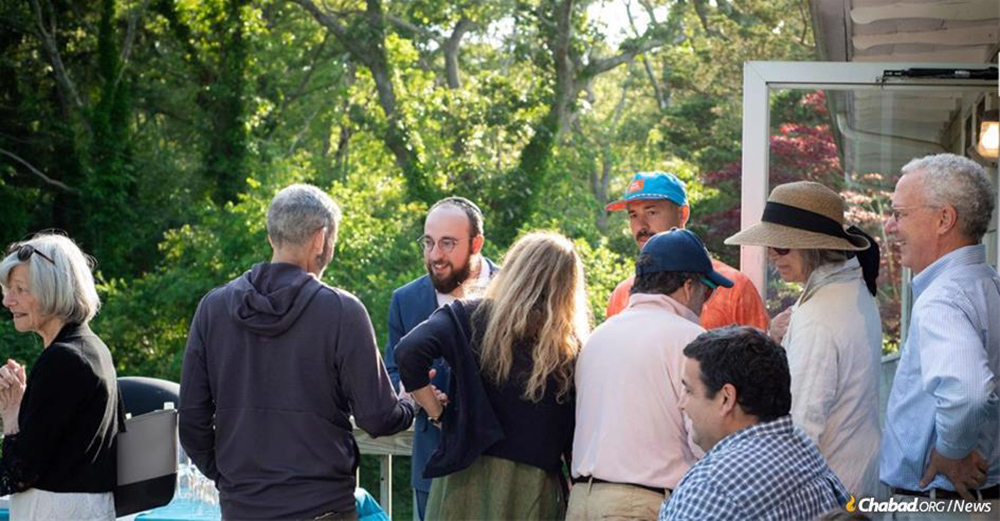Chabad-Lubavitch center opens in Massachusetts coastal hideaway
By: Kayla Rosen & Mendel Super
Martha’s Vineyard is, without a doubt, beautiful. There are majestic cliffs, white beaches and painted wooden homes with neat picket fences. Look out beyond the beach grass and sand, and you’ll see fishing boats bobbing in the blue sea. It is also undeniably charming, offering at once the feeling of a small village and being a world away. Part of this is due to its remoteness. Though just seven miles off the coast of Massachusetts, Martha’s Vineyard is accessible only by ferry or air.
Among its newest residents are Rabbi Tzvi and Hadassah Alperowitz and their 8-month-old son, Mendel, who arrived on the island in June to establish Chabad-Lubavitch of Martha’s Vineyard . The new center already has a permanent home—a sprawling house in Vineyard Haven originally built in 1890.
Vineyard Haven, also known as Tisbury, is the island’s main port and “has one of the highest year-round populations,” explains Jim Feiner, a local real estate agent and Jewish community member who helped Chabad find its clapboard dream home. “You can walk around nicely to stores and restaurants, concerts and events.” The Chabad House on Causeway Road is also only about a 10-minute walk from the Steamship Authority ferry terminal in Vineyard Haven, one of the handful of points of entry to the difficult-to-reach island.
While Martha’s Vineyard is widely known as an exclusive summer destination (when its population jumps to 200,000), it is also home to a small but growing year-round population of about 17,000. Chabad, like the lighthouses that dot the island’s rugged coasts, will be there for the long, bustling summer days, and the equally long, star-studded winter nights.
The Alperowitzes are focusing their work on year-round residents, in addition to the many others who come in the spring and stay for months at a time, for whom the island is also home. They are also gearing up to welcome the thousands of tourists and short-term visitors who arrive for the summer season.
“One of our most important goals is to create a space for connection, a place that every single Jew can call home,” Rabbi Alperowitz tells Chabad.org. “Whether that is for Torah study and prayer, to celebrate Shabbat and the holidays, or as a gathering place to enjoy a social community life, Chabad will create connection—to our Jewish heritage and to our Jewish family.”
The individuals who make up the Martha’s Vineyard’s Jewish community “come in all stripes and flavors,” notes Jim Shane, a member of Hillel International’s board of governors who’s been visiting the island for 42 years and became one of Chabad of Martha’s Vineyard’s earliest supporters. “We all have different needs, and Rabbi Alperowitz has found that there are Jews on the island looking for a connection that Chabad can satisfy.”
Shane, who became a year-round Martha’s Vineyard resident during Covid, was one of a number of local supporters who helped oversee the restoration and renovation process of the new Chabad center. “For me, my life’s work has been traveling the world for Hillel and Moishe House, and connecting members of the Jewish family together,” he says. “The faces are the same, the names are different, but we are all family.” That’s why reaching each and every person and providing them with a warm Jewish home is so important to him, around the world as much as on the Vineyard itself.
“Chabad is value added to the Jewish life of the entire community,” he says. “This is great for the Jewish community as well as the community at large. I’m excited to see what the future will bring.”
Longtime Martha’s Vineyard resident Harriet Schleifer sees it similarly. “As Jews, our peoplehood and our pride are most important, and it is incredible that we are able to offer a varied menu to help cultivate the Jewish connection through community,” Schleifer, outgoing national president of the American Jewish Committee and chair-elect of the Conference of Presidents of Major American Jewish Organizations, tells Chabad.org. “Chabad continues to help so many Jews discover their own Jewish identity in a space of non-judgment and acceptance.”
‘Growing Diversity and Healthy Lifestyle’
The first known Jewish settler on Martha’s Vineyard was an immigrant from Lithuania named Sam Cronig, who arrived there in 1905 at age 17 via New York’s Lower East Side. According to the Jewish Virtual Library, by 1917, Sam had saved enough money to bring his brothers, a sister and his future wife, Libby, from Minsk to Martha’s Vineyard. The same year, he opened Cronig’s grocery store, which today is the main supermarket on Martha’s Vineyard (there are virtually no chain stores on the island). Other early Jewish families included the Brickmans and the Isaaksons.
Though not all of them were strictly observant, they did their best to uphold Jewish tradition, holding a minyan when they could in Cronig’s living room, bringing kosher meat in from Boston and New Bedford, and lighting Shabbat candles. This and similar activity eventually led to the establishment of the Martha’s Vineyard Hebrew Center.
The main draw of the Vineyard lifestyle, says Feiner, who is also chairman of the housing commission in the town of Chilmark, is the “beautiful, safe environment, a high level of cultural sophistication, growing diversity and the healthy, outdoor lifestyle.”
Some of the island’s appeal lies in its almost idyllic seclusion, but this can also present difficulties. Look at a map, and Martha’s Vineyard appears remarkably close to the busy northeastern corridor, and in many ways, it is. But the reality is that often-stormy seas and limited transportation mean that many conveniences people take for granted on the mainland can be difficult to get a hold of on the island. This has presented locals—Jews among them—with difficulties for centuries, some of which can still be encountered today.
When a number of years ago, Shane found himself without a lulav and etrog, and the Sukkot holiday fast approaching, he was connected with Rabbi Yekusiel Alperowitz, who directs Chabad of Cape Cod together with his wife, Devorah, in Hyannis. The Alperowitzes have been serving the Jewish community on Cape Cod and the Massachusetts islands since 1995, and the rabbi was able to send Shane a lulav and etrog set by boat in time for the holiday.
The elder Rabbi Alperowitz is Rabbi Tzvi Alperowitz’s uncle. He’d long fielded requests for a permanent Chabad presence on Martha’s Vineyard, and as the island’s popularity boomed, so did its number of Jewish residents. This sea change also made it a lot more expensive and more difficult to get a new project of this kind off the ground.
Feiner says it wasn’t always like this. Growing up on the Vineyard, where his parents ran the Beach Plum Inn from the 1960s until the late ’80s, he recalls the island being more of “a seasonal destination, active for six to seven weeks during the summer.” Back then, it was more of a middle-class family, college-student-type getaway, with lots of undeveloped areas for camping and the like. “Housing wasn’t a problem like it is today, when you can’t find a home under a million dollars.”
Over the decades, more people kept discovering Martha’s Vineyard, including—but in no way limited to—global leaders in business, politics and the arts, drawn precisely by the unassuming and enchanting nature of the place. Covid and the new dawn of remote working made living permanently on Martha’s Vineyard an option for many more people; some estimate a jump of about 5,000 full-time residents, making the need for a Chabad center all the more clear. That’s when Cape Cod’s Rabbi Alperowitz thought of his nephew, Tzvi, who grew up in Bournemouth, England, where his parents serve as Chabad representatives, and niece Hadassah, whose parents direct Chabad of Weston, Fla.




